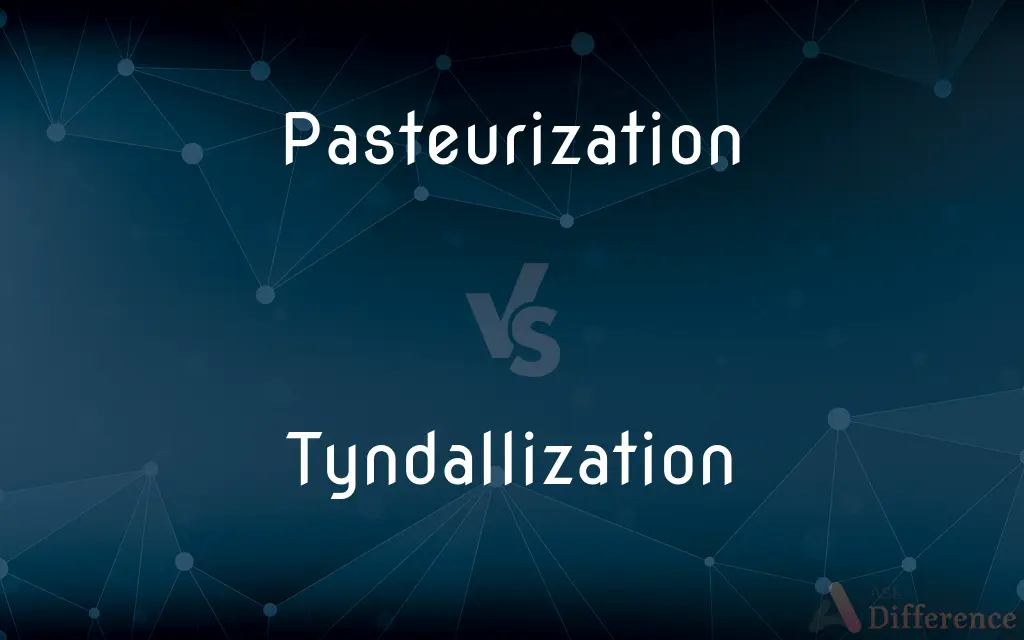Pasteurization vs. Tyndallization — What's the Difference?
By Tayyaba Rehman — Updated on October 31, 2023
Pasteurization is a process of heating food to kill harmful microorganisms, while Tyndallization is a sterilization method using intermittent heating.

Difference Between Pasteurization and Tyndallization
Table of Contents
ADVERTISEMENT
Key Differences
Pasteurization involves heating liquids to a specific temperature for a set period to kill most bacteria and microorganisms that cause disease or spoilage. This method was pioneered by Louis Pasteur in the 19th century. Tyndallization, named after John Tyndall, also aims to destroy microbes but is especially useful for neutralizing spores that can survive typical pasteurization temperatures. It does this through a process of intermittent steaming, where the substance is heated and then allowed to cool over several days to encourage spores to germinate into a more vulnerable form before reheating.
Pasteurization is typically performed between 60°C and 85°C, whereas Tyndallization operates at boiling temperatures but in a discontinuous or stepwise fashion. Pasteurization is widely used in the dairy and beverage industries and is known for its role in making milk and juices safe for consumption. Tyndallization is less common and more time-consuming but is useful when materials cannot withstand the higher temperatures of autoclaving, which is a more extreme form of sterilization.
While pasteurization does not result in sterility and some microbes may survive, it makes food products safe for consumption and extends their shelf life. Tyndallization aims for a greater level of sterilization, making it useful for more sensitive environments such as laboratory and certain medical contexts where more complete sterilization is required.
Both methods have their place in microbial control strategies, but pasteurization is more widespread due to its balance of efficiency and effectiveness. Tyndallization is more specialized and tends to be used when the items being sterilized are heat-sensitive or when the equipment for more efficient sterilization is not available.
Comparison Chart
Temperature Range
Typically 60°C to 85°C
At or near 100°C
ADVERTISEMENT
Process Type
Continuous heating
Intermittent heating
Time for Process
Shorter duration (seconds to minutes)
Longer duration (days)
Common Usage
Dairy and beverage industry
Laboratory sterilization of certain mediums
Effect on Microbial Spores
Does not effectively kill spores
Designed to neutralize spores
Compare with Definitions
Pasteurization
A method to extend the shelf life of perishables.
Pasteurization keeps the milk fresh for longer.
Tyndallization
A three-day cycle of heating and cooling for sterilization.
Tyndallization requires precise temperature control.
Pasteurization
Process reducing the risk of foodborne illness.
Juice safety is improved through pasteurization.
Tyndallization
A method to destroy heat-resistant spores.
The lab technician recommended tyndallization for spore inactivation.
Pasteurization
Heat treatment to destroy pathogens in food and drinks.
Milk is often safe to drink after pasteurization.
Tyndallization
A process requiring multiple exposures to steam heat.
Tyndallization effectively sterilized the nutrient broth.
Pasteurization
A mild heat application preserving food qualities.
Pasteurization retains the flavor of the cider.
Tyndallization
Sterilization via intermittent steaming.
Tyndallization was used to prepare the growth medium.
Pasteurization
Pasteurization or pasteurisation is a process in which packaged and non-packaged foods (such as milk and fruit juice) are treated with mild heat, usually to less than 100 °C (212 °F), to eliminate pathogens and extend shelf life. The process is intended to destroy or deactivate organisms and enzymes that contribute to spoilage or risk of disease, including vegetative bacteria, but not bacterial spores.The process was named after the French microbiologist, Louis Pasteur, whose research in the 1860s demonstrated that thermal processing would deactivate unwanted microorganisms in wine.
Tyndallization
An alternative sterilization technique to autoclaving.
We'll use tyndallization for these heat-sensitive instruments.
Pasteurization
The act or process of heating a food, especially a beverage such as milk or beer, to a specific temperature for a specific period of time in order to kill microorganisms that could cause disease, spoilage, or undesired fermentation.
Tyndallization
Tyndallization is a process dating from the nineteenth century for sterilizing substances, usually food, named after its inventor, scientist John Tyndall, that can be used to kill heat-resistant endospores. Although considered old-fashioned, it is still occasionally used.
Pasteurization
The act or process of destroying most microorganisms in certain foods, such as raw meat or fresh fruits and vegetables, by irradiating them with gamma rays or other radiation to prevent spoilage.
Tyndallization
Alternative form of Tyndallization
Pasteurization
Alternative spelling of pasteurisation
Pasteurization
A process devised by Pasteur for preventing or checking fermentation in fluids, such as wines, milk, etc., by exposure to a temperature of 140° F., thus destroying the vitality of the contained microorganisms.
Pasteurization
Partial sterilization of foods at a temperature that destroys harmful microorganisms without major changes in the chemistry of the food
Pasteurization
A standard food safety practice in the industry.
The company uses pasteurization for all its dairy products.
Common Curiosities
Is tyndallization practical for large-scale food processing?
No, it's generally too time-consuming for large-scale use.
Why is pasteurization widely used in milk processing?
It makes milk safe to consume without altering its quality significantly.
Is tyndallization more effective than pasteurization?
It is more effective at killing spores than standard pasteurization.
Can pasteurization achieve sterilization?
No, it reduces but does not eliminate all microbial life.
How long does pasteurization typically take?
It can range from seconds to minutes, depending on the method used.
What is the main goal of pasteurization?
To kill harmful microorganisms in food and drinks.
Why isn't tyndallization more common?
It's less efficient than other sterilization methods like autoclaving.
What microbes are targeted by tyndallization?
Particularly bacterial spores that can survive pasteurization.
Does pasteurization change the taste of food?
It can slightly alter the taste but aims to preserve it as much as possible.
What types of equipment are needed for tyndallization?
A steamer or heat source that can bring materials to near-boiling temperatures.
Can tyndallization be used on all materials?
No, it's not suitable for materials that can't withstand repeated heating and cooling.
Can I use tyndallization at home?
It's not practical for home use due to the complexity and time required.
Does pasteurization kill all bacteria in milk?
It kills most bacteria but not all, especially not heat-resistant spores.
Does pasteurization require special monitoring?
Yes, precise temperature and time control are essential.
Are there different methods of pasteurization?
Yes, including high-temperature short-time (HTST) and ultra-high-temperature (UHT).
Share Your Discovery

Previous Comparison
Goods vs. Product
Next Comparison
Benediction vs. InvocationAuthor Spotlight
Written by
Tayyaba RehmanTayyaba Rehman is a distinguished writer, currently serving as a primary contributor to askdifference.com. As a researcher in semantics and etymology, Tayyaba's passion for the complexity of languages and their distinctions has found a perfect home on the platform. Tayyaba delves into the intricacies of language, distinguishing between commonly confused words and phrases, thereby providing clarity for readers worldwide.














































